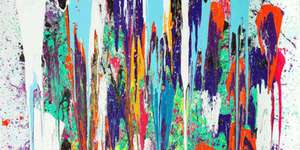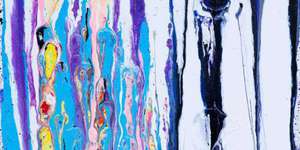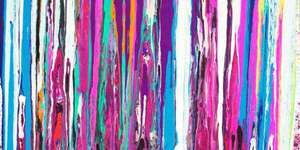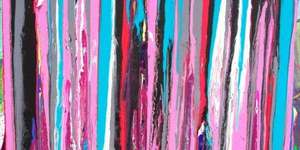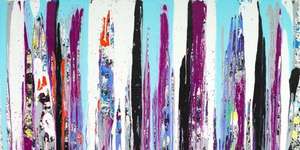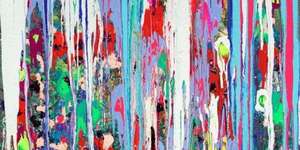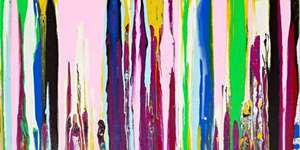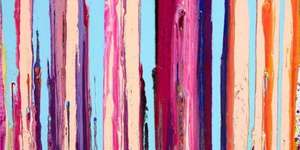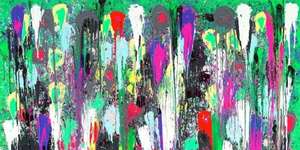FRANK JONS, THE REBEL OF COLOUR
Main influences: Estève, Poliakoff, Kandinsky, De Staël
After studying accounting and finance and working for 7 years as a company treasurer, my nocturnal hobby of painting ended up becoming a vital need. The turning point was an animated discussion with a DHR which made me decide to be free… come what may! So, in other words, my career as a painter took a little while coming.
I first started out with oil pastels on paper, because it was an economical option that offered the possibility to create with total freedom. Then I stumbled upon a set of oil paints that I had been given one Christmas and began painting in the classic way on an easel. But I was really frustrated not to feel the same rush as I did when painting with pastels. I was looking for another way of painting, where the tube, used like a paintbrush, would be an extension of the hand, with the freedom of using paint like oil pastels, switching from one to another without having to think about anything other than the creation itself.
The support then descended towards the ground. The oil had been replaced by acrylic paints and pigments. I began to paint on cardboard which I fixed onto old pallets that I found abandoned around town. It took me many years and an 8-month journey around the USA in a camper van to definitively paint on the ground itself and with acrylic.
It was through creating at night that I realized that I needed extra energy to take my painting to a new level. And the answer was music; rock, electro, and Indie rock, at full volume, as a guide and an emotional catalyst. I don’t listen to the same music when preparing my frames as I do when I paint.
The way I see it, creating to music is like entering into a trance so that the mind and body are totally liberated and can catapult all the emotions onto the canvas. There is no first draft, no mental preparation. What counts is the instinct, the discovery, the surprise, the accident.
It is a physical engagement in the strict sense of the term, a constant battle where rage, tenderness, sadness, love, and joy mix together and clash with each other. The music is loud. Stuck on the same track, it ends up grating on me. I am above the painting, I pace around it, I become one with it.
A painting made of concentration and fluidity, but also of contradiction: between the energy of the first moments and the calm of the maturation, between the passion of sentiments and the feeling of peace that follows, between the violence of chaos and the gentleness of love. It is the story of my inner turmoil.
Frank Jons, March 2012
Fans of the jubilatory painting of Frank Jons may be surprised and even slightly unsettled at the sight of the artist’s recent works displayed in the Espace Corniche of the Nosbaum & Reding Gallery.
Effectively, Jons, the great colourist, gives even more freedom to the matter itself. The colour is totally liberated and frees itself in gigantic streaks resembling a cascade of acidulated tones. This autonomy and gestural energy has been germinating for some years in the artist’s paintings. By working with pastilles and filaments and by subdividing the pictorial field, Frank Jons was expressing his energy and at the same time his formal mastery.
Today, in the ambitious formats upon which he is most expressive, the painter shows us the full paradox of his production. The chromatism is certainly appealing, some might say decorative, and always full of freshness. However, beneath this initial varnish which quickly cracks away, there is something extremely profound and sensitive.
Frank Jons, the rebel of colour, turns his canvases into his personal diary in which he cries out and immortalises his notion of love, his rage, his outbursts of melancholy, his dissatisfaction in the face of his creative act which sometimes preoccupies him. Submerged by an inexorable need to explore and express his deepest secrets, he surfs on the wave of inspiration, rejoices in this trance, and uses colour as a vector.
The result is instinctive, eruptive painting that bursts with energy and perfectly reflects the independence of its creator’s artistic angle.
Sporting his look of eternal adolescent with panache, Frank Jons could appear a little nonchalant to some. This exhibition allows us to discover an as yet little-known facet of his personality: that of maturity. Frank Jons dotes his works with diverse atmospheres, heightening their comprehension through the titles.
So, we can’t but see such work as a representation of the artist’s experience. In total intimacy, the painter reveals himself but, as if under a layer of modesty, does so with parsimony and intelligence.
By Nathalie Becker, journalist
Exhibition at the Nosbaum & Reding Gallery in 2010
It is the freshness of Frank Jons’ paintings that surprises us, probably due to the generous use of colour. We can rapidly find parallels in history of art, as well as in the more recent works of street art. This vast domain, in which the independence of the artistic angle appears through gestural expression, opens up a host of interpretations. The streaks of colour – which, in their accumulation, form the composition of the image – may seem arbitrary, but as we look at these paintings, we can make out the formal mastery in the work of Frank Jons. Each painting transmits a different atmosphere and often the artist underlines this particularity in the choice of titles. It is a way for the artist to recreate an intimate link with his life experience.
Alex Reding, Nosbaum & Reding Gallery

